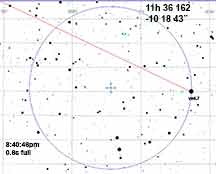


This shadow just gets the SW corner of Santa Cruz. Good odds (nominally) from Natural Bridges, where I will try it. The shadow then heads out into the Monterey Bay and no chance from Cabrillo Observatory or for Karl. Duration = 0.6s so this will be tough. Don't integrate too long.
Alt=23 Az=124 with the top lip star of Crater on the left edge of the eyepiece field of view. Sun= -14
 |
 |
 |
I was the only observer for this event, which came in very much as predicted...
I observed at 4x, from the ag road offshoot from the Wilder Ranch State Park parking lot. Skies were clear, moist, filled with mosquitoes. I used 5px fixed circular apertures for ref1, ref2, and the target, to insure keeping all starlight inside the circle. I note that the empty sky curve, as often seen, doesn't quite average around the 0 level, but slightly above. The depth of the occultation, I don't believe, takes this into account in deciding the amount of the mag drop. The average level of the "no-star" aperture was not 0, but instead was about 50. If you take this as the true zero level, the mag drop seen below would be much larger and more appropriate to the prediction. The 0.46s drop occured precisely on schedule.
Report sent into IOTA 4/10/24
magDrop report: percentDrop: 78.7 magDrop: 1.678 +/- 0.439 (0.95 ci)
DNR: 4.35
D time: [03:40:45.7440]
D: 0.6800 containment intervals: {+/- 0.0151} seconds
D: 0.9500 containment intervals: {+/- 0.0381} seconds
D: 0.9973 containment intervals: {+/- 0.0759} seconds
R time: [03:40:46.2068]
R: 0.6800 containment intervals: {+/- 0.0151} seconds
R: 0.9500 containment intervals: {+/- 0.0381} seconds
R: 0.9973 containment intervals: {+/- 0.0759} seconds
Duration (R - D): 0.4628 seconds
Duration: 0.6800 containment intervals: {+/- 0.0224} seconds
Duration: 0.9500 containment intervals: {+/- 0.0501} seconds
Duration: 0.9973 containment intervals: {+/- 0.0933} seconds
|
I set the metric interval as the entire interval before the occultation. Minimized metric in smoothing was over 64 points, and because it was low altitude (23 deg), and because the ref star was several arcmin from the target, I allowed for faint haze layers to migrate in time from one to the other, by the x-offset. Minimum wsa best with an offset of 10 points, or about 0.8 seconds, a reasonable number |
PyOTE was then given the likely D and R ranges, and found a solution |
Zoomed in. I've inserted the "zero" level of the sky as shown from the PyMovie light curve of "no-star". A level of 50. The predicted depth was over 5 magnitudes (less than 1% above the zero level. The data support the prediction very well. |
The solution passed the 5-sigma false positive test |